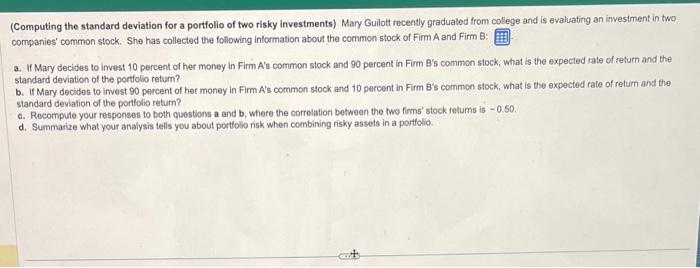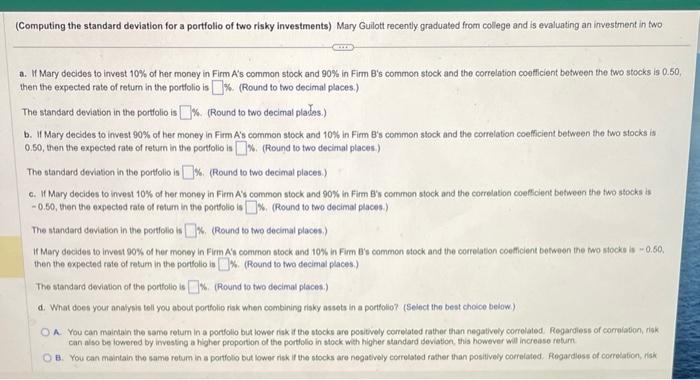\begin{tabular}{lcc} & Expected Returns & Standard Deviation \\ \hline Firm A's common stock & 0.15 & 0.12 \\ Firm B's common stock & 0.08 & 0.09 \\ Correlation coefficient & 0.50 & \\ \hline \end{tabular} (Click on the icon in order to copy its contents into a spreadsheet.) (Computing the standard deviation for a portfolio of two risky investments) Mary Guilott recently graduated from college and is evaluating an investment in two companies' common stock. She has collected the following information about the common stock of Firm A and Firm B: a. If Mary decides to invest 10 percent of her money in Firm A's common stock and 90 percent in Firm B's common stock, what is the expected rate of refurn and the standard deviation of the portfolio return? b. If Mary decides to invest 90 percent of her money in Firm A's common stock and 10 percent in Firm B's common stock, what is the expected rate of retum and the standard deviation of the portfolio return? c. Recompute your responses to both questions a and b, where the correlation between the two firms' stock returns is - 0.50. d. Summarize what your analysis tells you about portfollo risk when combining risky assels in a portfolio. a. If Mary decides to invest 10% of her money in Firm A's common stock and 90% in Firm B's common stock and the correlation coofficient between the two stocks is 0.6 then the expected rate of retum in the portlolio is \%. (Round to two decimal places.) The standard deviation in the portfolio is . . (Round to two decimal plactos.) b. If Mary decides to invest 90% of her money in Firm A's common stock and 10% in Firm B's common stock and the correlation coefficient between the fwo stocks is 0.50, then the expected rate of return in the portfolio is W. (Round to two decimal places.) The standard deviation in the portfolio is %. (Round to two decimal places.) c. If Mary decides to invest 10% of her money in Firm A's common stock and 90% in Firm B's cornmon stock and the correlation coeffient between the two stocks is 0.50, then the oxpectod rate of fetuin in the portolio is K1. (Round to two decimal places.) The standard deviation in the portiolo is \&. (Round to two decimal places.) If Mary decides to ifvest 90% of her money in Firm Al' common stock and 10% in Firm B's common stock and the correlation coetficient between the two stocks is "0.50. then the expected rate of return in the portfolo is 6. (Round to two decimal places.) The standard deviation of the portfolio is \%. (Round to two decimal places.) d. What does your analysis toll you about portfolio risk when combining risky assets in a portfolio? (Select the best choice beiow.) A. You can maintain the same retum in a ponfollo but lower risk if the stocks are positivily corredated rather than negatively correlated. Regardiess of correiabin, rigk can also be iowered by investing a higher proportion of the portlolo in stock with higher standard seviation, this however will increase return. B. You can maintain the same retum in a portfolo but lower risk if the stocks are negativoly correlated rather than positively correlated. Pegardloss of correlation, ifsik









